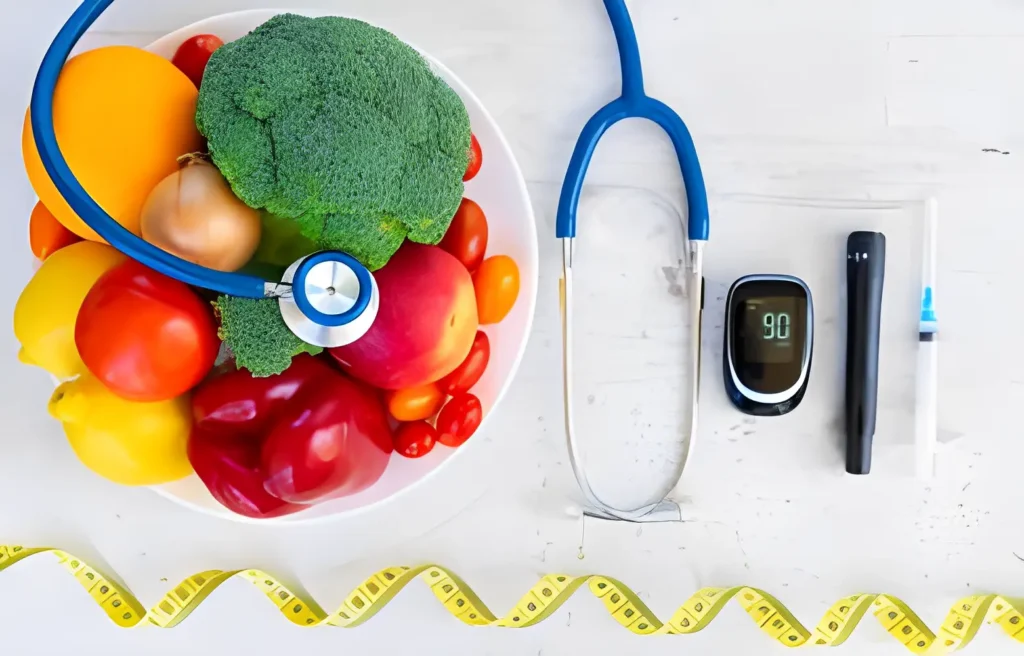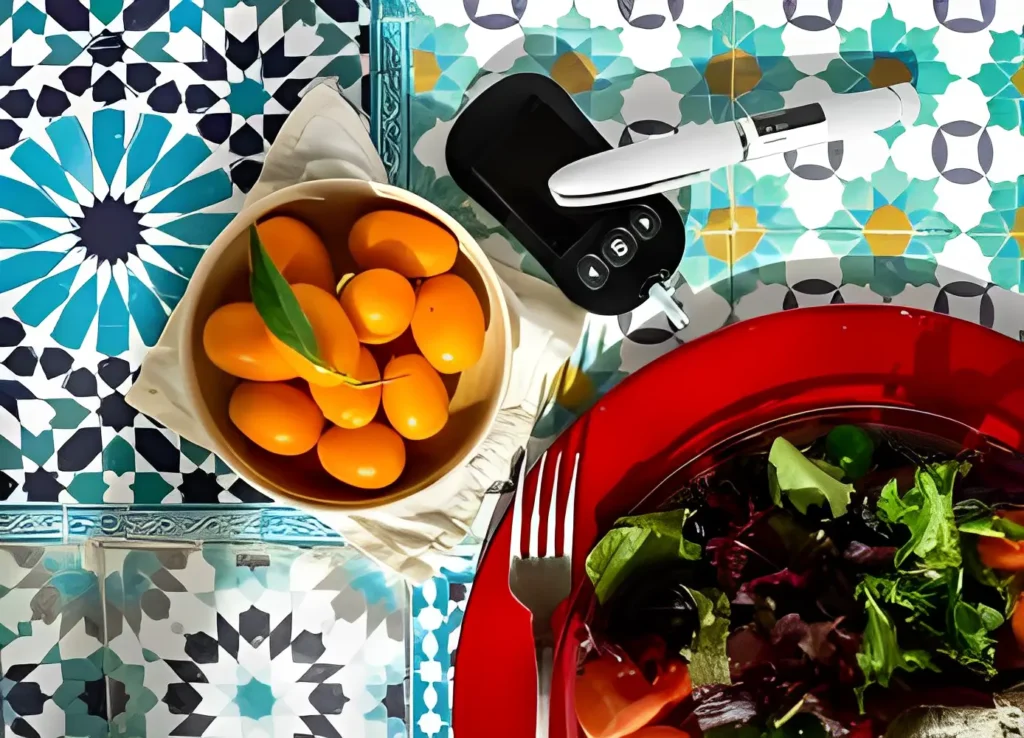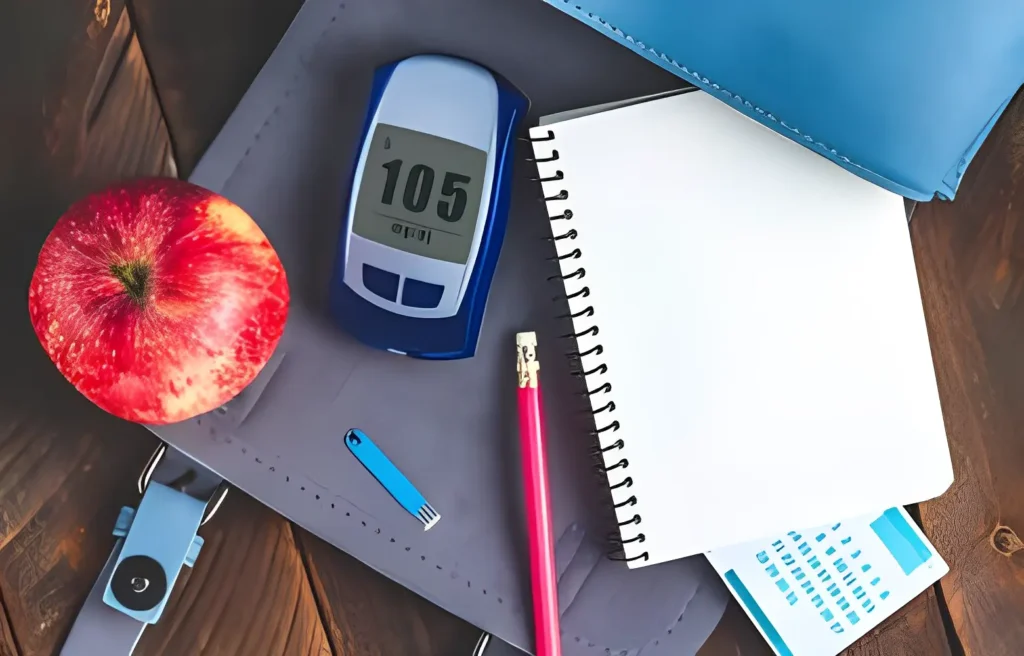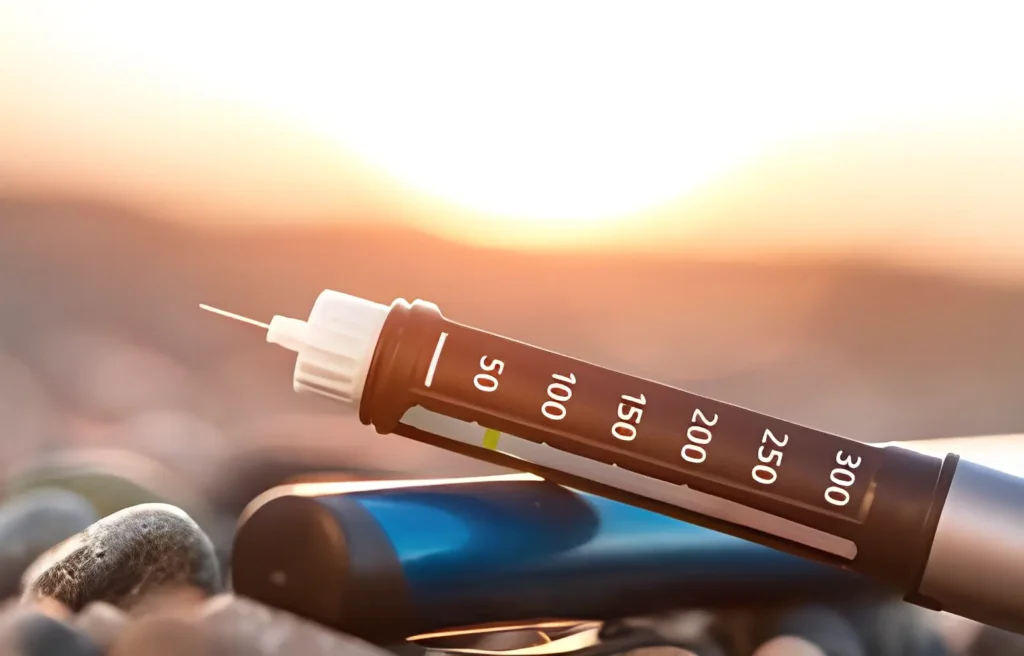Experiencing post-sugar crashes, lingering fatigue, or weight loss frustration? The insulin resistance diet could be your key to feeling empowered and balanced, naturally.
But what exactly is insulin resistance? Think of insulin as your body’s key, unlocking the door for sugar (glucose) to enter your cells and fuel your energy. With insulin resistance, the key gets a little rusty, making it harder for glucose to enter, leading to high blood sugar levels.
Hold on, high blood sugar? Isn’t that just pre-diabetes or type 2 diabetes? You’re not wrong! Unmanaged insulin resistance can indeed pave the way for these conditions, but it’s not a one-way street. The good news: with the right approach, you can improve your insulin sensitivity and regain control of your health.
Here’s the catch: while genetics play a role, lifestyle is your superpower. And that’s where the insulin resistance diet comes in, like a personalized training program for your metabolism.
Intrigued? We’ll delve deeper into the science behind insulin and blood sugar, explore the potential health risks, and unveil the secrets of the insulin resistance diet. Buckle up, because we’re about to empower you to take charge of your health, one delicious, nutritious bite at a time!
Ready to unlock your body’s potential? Let’s dive in!
I. Dietary Guidelines for Insulin Resistance Diet:

Feeling overwhelmed by insulin resistance? You’re not alone. But before you dive headfirst into complicated “miracle cures,” let’s chat about your food choices. The insulin resistance diet isn’t a one-size-fits-all fad, but a way to build a healthy relationship with your plate. Ditch the processed junk and embrace vibrant, whole foods that work with your body, not against it.
Nature’s Powerhouse: Fruits and Vegetables
Think vibrant rainbows! Fruits and vegetables aren’t just delicious, they’re packed with fiber, vitamins, and minerals that help regulate blood sugar and boost insulin sensitivity. So, ditch the juice cleanse and reach for whole fruits like berries, apples, and pears (bonus points for the skin!). Go green with leafy veggies like spinach and kale, or explore colorful cruciferous wonders like broccoli and cauliflower. Don’t forget nature’s candy: tomatoes, peppers, and even sweet potatoes (enjoyed in moderation) offer a sweet, nutrient-rich punch. Remember, variety is key!
Whole Grains: Fueling Your Day the Right Way
Refined grains might taste good, but their stripped-down nature sends blood sugar soaring. Instead, opt for whole grains like brown rice, quinoa, oats, and barley. These nutritional powerhouses are packed with fiber that keeps you feeling full and slows down the release of sugar into your bloodstream, helping your body manage insulin levels effectively. Feeling adventurous? Explore ancient grains like amaranth, farro, and teff for added variety and nutrients.
Lean Protein Powerhouses: Partners in Progress
Don’t skimp on the protein! While not magic bullets, lean protein sources like grilled chicken, fish, beans, lentils, and tofu provide essential amino acids that support tissue repair and metabolism. Remember, portion size matters! Opt for smaller portions (think palm-sized) and choose skinless poultry and fish for lower saturated fat content. Feeling creative? Get your protein fix with plant-based options like tempeh or edamame, both rich in fiber and nutrients.
Healthy Fats: Don’t Fear the Fat
Fat gets a bad rap, but not all fats are created equal! Healthy fats like those found in olive oil, avocados, nuts, and seeds promote heart health and can even improve insulin sensitivity. Don’t shy away from these good-for-you fats, but remember moderation is key. A drizzle of olive oil, a handful of nuts, or half an avocado can add flavor and satisfaction to your meals without overdoing it.
Processed Food Foes: Outsmarting the Sugar Spikes :
Ready to say goodbye to the processed food aisle? Let’s be honest, it’s tempting, but those hidden sugars, unhealthy fats, and refined carbohydrates wreak havoc on your insulin resistance diet. Sugary drinks and processed snacks spike your blood sugar, leaving you feeling hungry and craving more. Opt for homemade snacks with whole ingredients, and read labels carefully. Words like “high-fructose corn syrup” and “hydrogenated oils” are red flags – leave them on the shelf!
Added Sugars and Artificial Sweeteners: Sweet Deception
Sugar adds flavor, but at what cost? Added sugars in sodas, candy, and processed foods quickly raise blood sugar levels, making your body work overtime to produce insulin. This can contribute to insulin resistance in the long run. Even artificial sweeteners, while calorie-free, can trick your body and impact insulin sensitivity. Instead, sweeten your life naturally with fruits, spices like cinnamon, and a squeeze of lemon. Remember, small indulgences are okay, but moderation is key!
Refined Carbohydrates: The Blood Sugar Rollercoaster
White bread, pastries, and sugary cereals might seem harmless, but their refined nature means your body quickly breaks them down into sugar, leading to blood sugar spikes and crashes. This constant rollercoaster can exacerbate insulin resistance. Instead, focus on complex carbohydrates from whole grains, legumes, and vegetables. They break down slower, providing sustained energy and keeping your blood sugar levels stable. Remember, swapping white for brown is a simple yet impactful change!
Saturated and Trans Fats: Hidden Enemies
Saturated and trans fats found in fried foods, fatty meats, and processed snacks aren’t just bad for your heart, they can also contribute to insulin resistance. Saturated fats increase inflammation, while trans fats disrupt your body’s natural insulin response. So, limit fried foods, choose lean protein sources, and avoid processed snacks.
Mastering the Art of Portion Control and Mindful Eating:
Winning the portion battle:
Okay, we’ve talked about choosing the right foods, but how much should you put on your plate? Think “quality over quantity.” Start small and listen to your body’s hunger cues. Stop eating before you feel stuffed. Remember, your stomach takes time to send signals to your brain, so savor your food and eat slowly.
Tips for mindful eating:
- Ditch distractions: Eat at the table, put away your phone, and focus on the food. Engage your senses! Notice the colors, aromas, and textures of your meal.
- Plan your meals: Avoid spontaneous, rushed meals that often lead to unhealthy choices. Planning ahead helps you control portions and make wiser decisions.
- Embrace variety: Don’t get stuck in a rut! Explore different ingredients and recipes to keep things interesting and prevent cravings for “forbidden” foods.
- Cook more at home: This gives you complete control over ingredients and portion sizes. Plus, cooking can be a fun and mindful activity!
- Don’t beat yourself up: We all make slip-ups. The key is to learn from them and move on. Focus on progress, not perfection.
Sample Meal Plans and Recipes:
Ready to put these tips into action? Remember, there’s no one-size-fits-all plan. Explore resources like the American Diabetes Association or consult a registered dietitian for personalized meal plans and recipes that fit your needs and preferences. But here’s a sneak peek to get you started:
Breakfast: Greek yogurt with berries and granola, scrambled eggs with whole-wheat toast and avocado, or oatmeal with nuts and seeds.
Lunch: Quinoa salad with grilled chicken or fish, lentil soup with a whole-wheat roll, or a veggie wrap on whole-wheat tortilla.
Dinner: Salmon with roasted vegetables and brown rice, baked chicken breast with sweet potato and steamed broccoli, or lentil pasta with a vegetable-based sauce.
Snacks: Fruits and vegetables with hummus, nuts and seeds, air-popped popcorn, or Greek yogurt with berries.
Remember, these are just examples! Use them as inspiration and experiment to find what works best for you on your insulin resistance diet journey.
Remember, consistency is key! By making small, sustainable changes and embracing a mindful approach to eating, you can fuel your body for balance and improve your insulin sensitivity for a healthier, happier you.
II. Additional Dietary Approaches for Insulin Resistance:

Curious about venturing beyond the basics of the insulin resistance diet? Buckle up, because we’re diving into three popular dietary patterns that might be a perfect fit for you!
The Mediterranean Diet: Sunshine on Your Plate :
Picture yourself strolling through a sun-drenched Mediterranean market, surrounded by vibrant fruits, vegetables, and healthy fats. That’s the essence of this delicious and nutritious approach. It emphasizes:
- Olive oil as the primary fat source: Rich in monounsaturated fats, olive oil helps reduce inflammation and improve insulin sensitivity.
- Plenty of fruits and vegetables: Nature’s bounty provides fiber, vitamins, and minerals that stabilize blood sugar and enhance insulin function.
- Whole grains over refined carbohydrates: Think brown rice, quinoa, and whole-wheat bread for sustained energy and better blood sugar control.
- Moderate fish and lean protein: Enjoy salmon, tuna, and lentils for essential nutrients without overloading on saturated fat.
- Limited red meat and processed foods: These can negatively impact your insulin resistance diet journey.
Sounds good, right? Research suggests the Mediterranean diet can improve insulin sensitivity, reduce inflammation, and even lower your risk of type 2 diabetes. Intrigued? Here’s a sample meal plan to whet your appetite:
Breakfast: Greek yogurt with berries and granola drizzled with olive oil. Lunch: Chickpea salad sandwich on whole-wheat bread with a side of grilled vegetables. Dinner: Baked salmon with roasted tomatoes and quinoa. Snacks: Fresh fruit with nuts and seeds, hummus with carrot sticks.
Ready to explore further? Check out credible resources like the American Heart Association’s Mediterranean Diet guide for more recipes and meal plan ideas.
The DASH Diet: Taking Control of Sodium :
Ever feel puffy-faced or sluggish? High blood pressure, often linked to sodium overload, can worsen insulin resistance. Enter the DASH diet, designed to naturally lower blood pressure through:
- Limiting sodium intake to 2,300mg per day: Gradually reduce salt and choose low-sodium products.
- Focusing on fruits, vegetables, and whole grains: These are naturally low in sodium and rich in beneficial nutrients.
- Including low-fat dairy products: Calcium supports bone health and may even play a role in regulating blood sugar.
- Moderate portions of lean protein: Opt for lean meats, fish, and legumes for protein power without excessive saturated fat.
- Limiting saturated and trans fats: Found in fried foods and processed snacks, these can hinder insulin sensitivity.
But can it improve insulin resistance too? Studies show promise! By promoting healthy blood pressure levels and supporting metabolic health, the DASH diet can be a valuable tool for managing insulin resistance.
Here’s a DASH-inspired meal plan to get you started:
Breakfast: Oatmeal with berries and almonds, low-sodium milk. Lunch: Salad with grilled chicken, avocado, and vinaigrette dressing. Dinner: Baked cod with roasted sweet potato and steamed broccoli. Snacks: Apple slices with low-fat cheese, air-popped popcorn.
Want to dive deeper? The National Heart, Lung, and Blood Institute offers comprehensive DASH diet resources, including recipes and sample menus.
Intermittent Fasting: Playing with Time:
Intrigued by the idea of cycling between eating and fasting periods? Intermittent fasting (IF) might be on your radar. It involves structured periods of fasting, ranging from 16 hours to several days, interspersed with eating windows. Different methods exist, such as:
- 16/8 method: Fast for 16 hours (e.g., dinner to the next day’s lunch) and eat within an 8-hour window.
- 5:2 method: Eat normally for 5 days and restrict calories to 500-600 for 2 non-consecutive days.
Does it work for insulin resistance? Research suggests potential benefits, like improved insulin sensitivity, reduced inflammation, and even weight loss. However, it’s essential to:**
- Consult your doctor before starting IF: Ensure it’s safe for your individual health.
- Choose methods aligned with your lifestyle: Don’t force a restrictive approach that’s unsustainable.
- Prioritize whole, nutritious foods during eating windows: Don’t undo the benefits with unhealthy choices.
Remember, IF isn’t a magic bullet. It’s a lifestyle approach that may benefit some but not all. Listen to your body, consult healthcare professionals, and choose a method that fits your needs and preferences.
III. Lifestyle Modifications for Insulin Resistance:

Feeling like your insulin resistance diet needs a little extra oomph? You’re right! While food plays a pivotal role, lifestyle modifications pack a powerful punch too. Let’s explore how moving your body, catching Zzz’s, and managing stress can turbocharge your insulin sensitivity and help you feel your best.
Move it, groove it! Exercise isn’t punishment, it’s your body’s best friend. Regular physical activity makes your muscles more receptive to insulin, like unlocking a secret door to better blood sugar control. Aim for at least 150 minutes of moderate-intensity exercise each week, like brisk walking, swimming, or biking. Even small bursts, like taking the stairs or parking farther away, count! Remember, every step counts towards a healthier you.
Sleep: Nature’s reset button. Ever feel extra hangry after a sleepless night? It’s not just you! When you’re sleep-deprived, your body struggles to regulate hormones like insulin, potentially worsening insulin resistance. Aim for 7-8 hours of quality sleep each night. Create a relaxing bedtime routine, ditch the screens before bed, and make your sleep haven a tech-free zone. Sweet dreams for better blood sugar!
Stress: the silent saboteur. Feeling overwhelmed? Chronic stress wreaks havoc on your hormones, including insulin. When you’re stressed, your body pumps out stress hormones that can make it harder for your cells to use insulin. So, manage stress like a boss! Try yoga, meditation, deep breathing, or spending time in nature. Find what works for you and de-stress for better insulin sensitivity.
Weight: a balancing act. Carrying extra weight can put a strain on your body’s ability to use insulin effectively. Losing even a small amount of weight (5-10%) can significantly improve insulin sensitivity. Remember, this isn’t about crash diets, it’s about sustainable lifestyle changes like healthy eating and regular exercise. Work with your healthcare professional to create a safe and effective weight management plan.
Remember: these changes are meant to empower, not overwhelm. Start small, be patient, and celebrate your progress. Every step you take towards a healthier lifestyle is a step towards better managing your insulin resistance. You’ve got this!
Bonus tips:
- Connect with a community: Find support groups or online forums for people with insulin resistance. Sharing experiences and tips can be a powerful motivator.
- Talk to your doctor: They can offer personalized advice and monitor your progress.
- Don’t go it alone: Enlist the support of friends and family for encouragement and accountability.
Remember, you’re not alone on this journey! With a little effort and the right support, you can achieve a balanced life with insulin resistance.
Conclusion:
Ready to conquer the insulin resistance diet landscape? Don’t fret, it’s not about bland broccoli and deprivation. It’s about empowering your body with nutrient-rich choices that work in harmony with your unique needs.

Remember, this journey is yours. Experiment, explore, and personalize your approach. Find joy in healthy cooking, savor mindful meals, and celebrate small victories. It’s not a sprint, it’s a marathon – but a delicious, empowering one at that!
Still have questions? That’s perfectly normal! Navigating insulin resistance can feel overwhelming. But hey, you’re not alone.
- Reach out to a registered dietitian: They can create a personalized plan tailored to your preferences and health goals.
- Explore credible resources: The American Diabetes Association and the National Institute of Diabetes and Digestive and Kidney Diseases offer a wealth of information and support.
- Connect with online communities: Sharing your experiences and seeking encouragement from others on the same journey can be incredibly valuable.
So, take a deep breath, embrace the adventure, and remember: small changes, big impact. You’ve got this!
Sources:
The National Institute of Diabetes and Digestive and Kidney Diseases
Check out: Your Ultimate Guide to Food Tracker Success